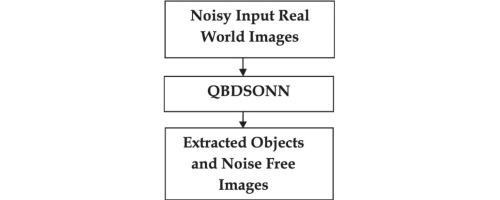A quantum bi-directional self-organizing neural network (QBDSONN) architecture for binary object extraction from a noisy perspective |
| |
| Affiliation: | 1. Department of Computer Science & Engineering, Sikkim Manipal Institute of Technology, Sikkim, India;2. Department of Information Technology, RCC Institute of Information Technology, Canal South Road, Beliaghata, Kolkata 700 015, India;3. Department of Electrical Engineering, Indian Institute of Technology Delhi, Delhi, India;4. School of Human Science and Environment, University of Hyogo, 1-1-12, Shinzaike-hon-Cho, Himeji 6700092, Japan;1. Division of Physics and Applied Physics, School of Physical and Mathematical Sciences, Nanyang Technological University, 637371 Singapore, Singapore;2. Department of Physics, Sultan Qaboos University, P.O. Box 36, PC 123 Muscat, Oman;3. Department of Physics, Shahid Beheshti University, Tehran 19839, Iran;4. Institute of Materials Research and Engineering, Agency for Science, Technology and Research (A*STAR), 138634 Singapore, Singapore;1. State Key Laboratory of Integrated Service Networks, Xidian University, Xi''an, 710071, China;2. School of Information, Xi''an University of Finance and Economics, Xi''an, 710100, China;1. Institute of Advanced Technology, Nanjing University of Posts and Telecommunications, Nanjing 210003, PR China;2. School of Automation, Huazhong University of Science and Technology, Wuhan 430074, PR China;3. School of Mechatronic Engineering and Automation, Shanghai University, 200072, PR China |
| |
| Abstract: | 
This article proposes an efficient technique for binary object extraction in real time from noisy background using quantum bi-directional self-organizing neural network (QBDSONN) architecture. QBDSONN exploits the power of quantum computation. It is composed of three second order neighborhood topology based inter-connected layers of neurons (represented by qubits) arranged as input, intermediate and output layers. In the suggested network architecture, the inter-connection weights and activation values are represented by rotation gates. A self-supervised learning algorithm, suggested in this proposed architecture, relies on the steepest descent algorithm. The quantum neurons enjoy full-connectivity in each layer of the network architecture. The image pixels in terms of qubits are self-organized in between the intermediate or hidden and output layers of the QBDSONN architecture using counter-propagation of the quantum states to obviate time consuming quantum back propagation algorithm. In the final phase, quantum measurement is carried out at the output layer to eliminate superposition of the quantum states of the outputs. In order to establish the result, the proposed QBDSONN architecture is applied on an artificial synthetic and on a real life spanner image with different degrees of uniform and Gaussian noises. Experimental results show that QBDSONN outperforms both its classical counterpart and the supervised auto-associative Hopfield network as far as extraction time is concerned and it retains the shapes of the extracted images with great precision. Experiments are also carried out using a linear method named local statistics (Wiener filter) and a nonlinear technique named median filter with adaptive discrete wavelet transformations (DWT) for binary object extraction to show the dominance of the proposed QBDSONN with respect to the quality of extracted images. Finally, a statistical significance of the proposed QBDSONN is reported by applying 2 sample one sided Kolmogorov–Smirnov test with the existing methods. |
| |
| Keywords: | Object extraction BDSONN Quantum computing QBDSONN Kolmogorov–Smirnov test |
| 本文献已被 ScienceDirect 等数据库收录! |
|

